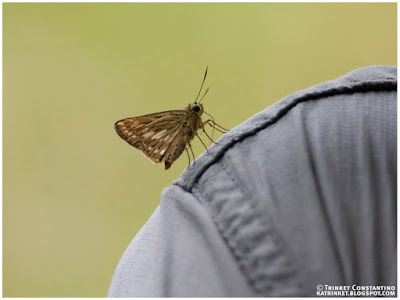Since we were already in the area and still had the weekend free after the Ibong Dayo Festival in Balanga, Adri and I decided to spend the night in Subic so we could go birding the next day.
Birding in Subic almost never disappoints and that Friday afternoon and Saturday morning was no exception. Woodpeckers, pigeons, coucals, malkohas, kingfishers, cuckoo shrikes, raptors, hornbills, barbets, tree swifts, dollarbirds, owls, plus all the other usual suspects were present. But my attention to the birds was distracted by another Subic flying attraction: buttterflies!
The moment I saw several Painted Jezebels, Delias hyparete, (looking freshly eclosed) flying around the flowering hagonoy, I knew butterly-ing would overtake birding (for me at least) that weekend!
Hagonoy, Chromolaena odorata Linn., is introduced from North America and is one of the world's worst invasive plants. Among its common names are Devil weed, Christmas bush and Butterfly weed: all reflecting its nature. It is very difficult to control and eradicate, it flowers around December and it is a nectaring plant for lepidopterans.
As the morning wore on, Adri was busy with the birds, and I was focused on the butterflies feeding on the profusion of white hagonoy flowers.
The easiest to photograph was the large and always friendly Cruiser, Vindula dejone.
It would alternate between feeding and sunning itself on nearby leaves.
Many other nymphalids were out feeding:
Satyr, Ptychandra lorquinii
Crow, Euploea sp.
Sailor (or one of those butterflies with a military rank, sergeant? How will I ever learn to get the ID correctly?!)
Zethera pimplea
Perhaps the star of the morning was a beautiful Banded Peacock, Achillides palinurus. It was unusually cooperative, perching on the white flowers rather than just the usually fast flight.
Its wings were still flapping very swiftly, the hindwings moving in figure of 8 pattern, so it took several tries to get it showing the upper side.
It was such a beauty, even Adri was pulled away from the Dollarbird he was photographing to join me in stalking this swallowtail.
Another papilionid present was the elegant Green Dragontail, Lamproptera meges.
Although much smaller, they were no less speedy, and darted from blossom to blossom.
There were also several skippers (hesperids) out and about. The easiest for me to identify (about the only one I can!) is this snow flat, Tagiades japetus.
Other skippers:
While a lot of the skippers were feeding, some were attracted to our equipment and to our clothes and skin! Probably in search of the minerals in our sweat.
This one spent a lot of time perched on the tripod.
While another one followed Adri around while he birded.
Skippers were not the only ones on the lookout for non-botanical perches!
Here is the same Vindula dejone as above, eye to eye with me as it rested on the camera strap on top of the car.
One of the few lycaenids that day was quite friendly, perching not only on our camera equipment, but on me and Adri alternately!
Aside from the Delias, several different types of pierids were actively feeding. It is easy to see why this family is referred to as whites and sulfurs/yellows.
There were several Chocolate Albatrosses, Appias lyncida.
Tree yellows, Gandaca harina (not sure on this ID either!)
White Albatrosses, Appias albina
Several very vibrantly colored Orange Albatrosses, Appias nero (one was quite larger, so I am not sure if this is the correct species) also were plenty.
Later, just as we were about to leave, it was a pleasant surprise to find several of the pierids puddling on the asphalt.
Side by side, I realised that the Chocolate Albatross (3rd from left on foreground in photo below) looked very similar (but not!) to the pierids beside it (2nd, 5th and 6th). Perhaps these were Cepora boisduvaliana ?
Notice the yellow and white mark on the apex of the forewing, as opposed to the single yellow mark. Argh to butterfly identification!
A common mormon, Menelaides polytes, joined the puddling pierids, looking like a giant beside them.
I was pleasantly surprised to see a favorite, the tiny lycaenid Caleta roxus also gathering minerals.
It was fast approaching noon and we had to drive back to the business district to check out of our hotel. It was difficult to leave such a beautiful sight, so we took a few (and by that I mean maybe a hundred) parting shots of the kaleidoscope on the road.
Birds AND butterflies. I love Subic.
Bird identification is sooo much easier than butterfly identification! I would appreciate identification and corrections to the ones I've made here. :-)





































No comments:
Post a Comment